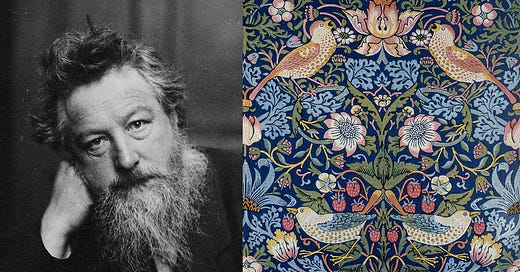William Morris, Drama Triangle, and Jusant (weekly wrap #16)
Exploring art, design, play, and victim consciousness
Something I’ve been inspired by
I’ve spent a lot of time over the past week connecting and reconnecting with art and design, for various reasons, and discovered (or rediscovered perhaps) an artist who’s work I was familiar with but had not paid much attention to - William Morris.
William Morris (24 March 1834 – 3 October 1896) was an English textile designer, poet, artist, writer, and socialist activist associated with the British Arts and Crafts movement. He was a major contributor to the revival of traditional British textile arts and methods of production.
Morris himself was an inspiring guy, with some poetic contemplations such as:
“There is no square mile of earth’s inhabitable surface that is not beautiful in it’s own way, if we men will only abstain from wilfully destroying that beauty.” – William Morris
But something I stumbled upon in my exploring of Morris and his work that really inspired me was some old world craftsmanship that manifested his visions into print (specifically wallpapers). You must check out this 3 minute video. Even if you have no interest in art, printing, wallpapers, etc. you’ll surely appreciate the technique and attention to detail that can go into human-made art that I wonder if we’re perhaps losing touch with in this day and age.
Something I’ve been revisiting
The Karpman Drama Triangle came up again recently in a conversation with a dear friend, and I found myself revisiting and re-appreciating the power of this model for the millionth time.
The drama triangle is a social model that helps explain unhealthy relationship patterns, especially in conflict. It was developed in 1968 by Dr Stephen Karpman, a psychiatrist who studied how people behave in stressful or emotional situations. He originally used the model while learning from Dr Eric Berne, the founder of transactional analysis – a theory about how people communicate.
The triangle has three roles that people can shift between during conflict: Victim, Rescuer, and Persecutor. These roles don’t mean someone is actually a victim or a bully. They describe how someone feels or acts in the moment.
The Victim feels helpless, powerless or hard done by.
The Rescuer tries to save or fix the situation, often without being asked.
The Persecutor criticises or blames others and acts in a controlling or harsh way.
People can switch between these roles quickly, which keeps the drama going. The triangle is a tool to help notice unhelpful patterns so we can respond differently and create healthier relationships.
My engagement with this model has predominantly been through the Conscious Leadership Group’s interpretation and presentation of it, which is slightly modified to fit into their model of personal and professional development. If you want to see the video I most often share about this, it’s this one.
If you want to see a video that’s more grounded in psychology and psychotherapy then this one from Psych2Go is very good.
Something I’ve been playing
Although I recently mentioned in a weekly wrap that I’m definitely not a gamer, incidentally I have actually been casually making my way through a game. Jusant is a 2023 puzzle platform game developed and published by Don't Nod. The player controls a lone wanderer as they climb a desolate tower, filled with the artifacts of civilizations long past.
In simple terms, it’s a game where you work through rock-climbing puzzles with very immersive climbing mechanics. But beyond that, it’s a really poetic and artistic experience.
As you wander through this desolate environment, you find and read notes left behind of others - some that chose to explore for hope from the desolation of a world with no more water, and some that chose to stay in the safe familiar, as dire as it may be. It really made me meditate on… you know what… just a lot of things that are beyond expression.
Here’s a nice review of the game that hints at some of it.




